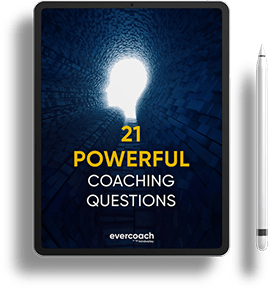Coaching Techniques
for every coach:
step-by-step Guide

Mastery doesn't happen overnight.
This is true whether you're learning how to ride a bicycle, teaching yourself a new language, learning to fly a plane or working on becoming a great coach.
The more you "rush it," the harder you try to get things done quickly, the more mistakes you make, the less you learn and the longer it takes.
To achieve mastery as a coach, you need to work with a few key ingredients:
Time
Patience
Practice
Effective Coaching Techniques & Tools
The first 3 ingredients are on you. You have to find the time and cultivate the patience to practice your coaching skills again and again and again.
But that last item on the list - effective coaching techniques and tools - that's something you don't have to do on your own.
This Guide is an introduction to some of the best coaching techniques and tools that are in use today.
This is not an exhaustive - every coaching tool and technique under the sun - list.
This is a high-value, curated list focusing on coaching practices and methods that have been proven to work in just about every coaching environment and with all kinds of clients, all over the world.
By the end of this Guide, you'll have a set of game-changing techniques in your toolkit to create lasting transformations and real results for your clients.
Ready to dig in? Let's go!
Why You Need Effective Coaching Techniques
Even though they've spent thousands of hours fine tuning their craft, even though they've been working with clients for years - sometimes even decades - the world's top coaches constantly turn to coaching frameworks that include tried-and-tested coaching techniques.
If you're a new coach, this might seem a little strange.
Why bother with techniques when you're an experienced coach? Why work with step-by-step methods when you can "go with the flow" and "be in the moment" with a client?
Here's the thing...
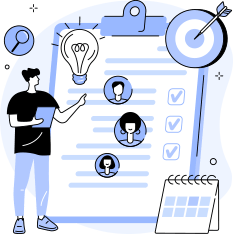
Great coaching isn't just about being creative and instinctive and it's not just about foundational skills such as deep listening or asking the right questions. At the highest level, coaching is about having an all-inclusive, comprehensive approach to your work.
Yes, it's about applying basic coaching skills and tapping into your empathy and intuition to create a deep trust and connection...
But there's more.
Powerful coaching is also about working with practical coaching techniques and tools.
When you focus on developing both of these opposing and equally important aspects of coaching - the fluid art and the practical craft of using tools and techniques - you will create a level of mastery few coaches ever reach.
Countless books, programs and trainings have been created to address the artistry and creativity around coaching, but the science - the actual tools, techniques, and methodologies to create deep and lasting results for clients - isn't as easily available.
Throughout this guide, we'll be diving into 5 of the best coaching techniques and tools that you can put into practice right away, when to use each one, and the step-by-step guide on how to apply them during a coaching session. These effective coaching techniques are: The Wheel of Life, The Moonshot Technique, The Spheres of Influence, The Time Travel technique, and The Eisenhower Matrix.
Use these techniques where you feel it will bring the most benefit to your clients and allow yourself to adapt what you learn, incorporate your own style and experience, or combine one with another as you see fit.
The Wheel of Life Coaching Technique
Here's the thing...
No matter how focused and disciplined your client is and no matter how hard they work...
Life can get in the way.
Priorities expand, shrink and change based on what's going on in their life.

That's why it's good to regularly assess where they are and how they feel about their current reality so they can get back on track if they need to.
One of the most effective coaching techniques to address this is The Wheel of Life.
The Wheel of Life is a powerful yet simple coaching tool that will allow your client to take an honest, non-judgmental look at some of the most important areas of their life.
This coaching technique will help them gain or regain a sense of direction, focus, purpose, and balance.
how to use this coaching technique
Start by asking your client to draw a circle on a sheet of paper.
Then have them divide the circle into 8 segments labelling each one with the following themes:
01 Family and Friends
02 Romance
03 Personal Growth
04 Business/Career
05 Finances
06 Health
07 Fun & Creation
08 Physical Envionment
Now ask your client to evaluate each segment on the Wheel on a scale of 1 to 10 -- 10 equals "extremely satisfied" and 1 equals "zero satisfaction."
Now, have them write that number in the segment.
An alternate version is to draw the Wheel and 8 segments, and then draw a line from the center of the wheel to the outer edge of each segment.
Finally, divide the line into 10 sections to mark the level of satisfaction within each category. See image below:
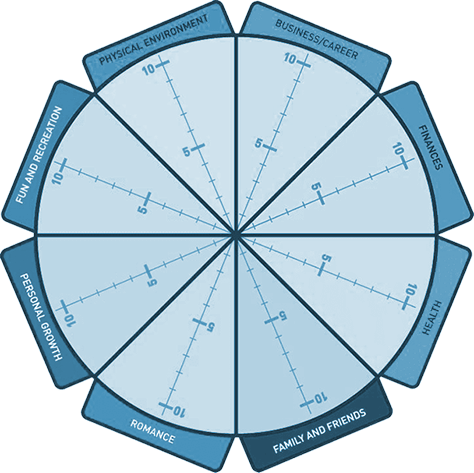
When your client is done, ask them to rank the weakest to the strongest segments in the Wheel, based on their evaluation.
Identify 1 to 3 actions your client can take to boost each category, starting from the weakest.
The Wheel of Life provides a visual representation of the contrast between the client's current reality and their desired reality.
It's a game-changing tool that's especially good for clients who feel a significant lack of balance, joy and satisfaction in their life.
The Moonshot Coaching Technique
The Moonshot Technique is perfect for clients who can't clearly identify life or work goals that inspire them.
This usually happens when a client has lost their sense of purpose, adventure, and excitement for life.
It's a symptom of feeling trapped in a meaningless daily routine filled with mundane activities that are boring and unchallenging to the client.
The Moonshot Goal technique will help resolve this problem.
how to use this coaching technique
Start by asking your client a series of questions that will take them out of their current thinking.
For instance...
What is a secret dream you had when you were a kid?
What are some activities and experiences that fill you with joy, excitement, and enthusiasm?
The idea is to motivate your clients to start thinking bigger and bolder and to remember long lost dreams and desires.
When they've answered your questions, have them start a list of things they'd love to do, be and have.
Give them free reign to come up with as many answers as they want.
Encourage them to go for "moonshot goals" - goals that feel huge and maybe even a little crazy but highly exciting.
This could be anything. A first class trip around the world, writing a New York Times bestseller or even reversing global warming.
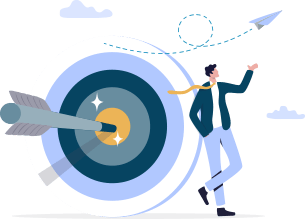
When they have their Moonshot Goal list, ask them to circle 1 to 3 goals. Goals that feel BIG but within reach.
Then work with them to break down each goal into smaller, doable steps.
For instance, if their dream is to write a New York Times bestseller, have them start working toward that dream by setting aside time to write every single day.
This coaching technique will help them gain or regain a sense of direction, focus, purpose, and balance.
One thing to keep in mind when using this technique is that clients may face a Possibility Hangover - they start overthinking about their ambitious goals and get stuck. This is where you step in to coach them out of that thinking spiral and into taking action.
The Spheres of Influence Coaching Technique
Sooner or later you're going to have a client come to you and say,
"I'm totally overwhelmed. I don't know what to do!"
The core feeling that drives overwhelm is a sense of helplessness... a loss of control.
The Spheres of Influence technique is incredibly effective process that will quickly empower your client to take back control in any area of their life.
The Spheres technique is simple and effective.
Your client will quickly see there are only 2 areas they need to focus on:
01. The things that are within their control
02. The things they can influence
They need to let go of everything else because it's outside their zone of control and influence.
how to use this coaching technique
Have your client draw 2 circles - a smaller circle within a large one.
Have them label the larger circle "The Things I Can Influence" and the smaller circle "The Things I Can Control."
Now, ask them to label the space outside the circles as "Everything Else."
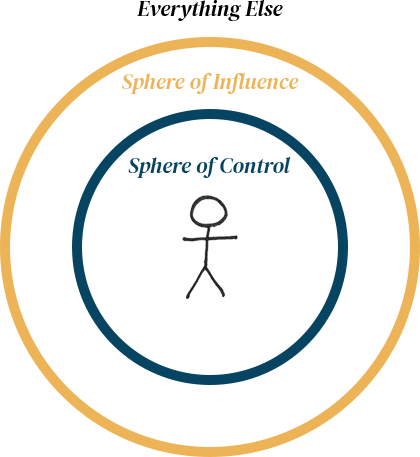
Next, walk them through the problem or challenge they're struggling with -- the situation that's triggering the feeling of overwhelm.
Get them to think about what needs to go into each circle, the things that are within their control and the things that they can influence, and list these out.
Example
Let's say your client is anxious, stressed and overwhelmed because her company is downsizing due to an economic downturn. There's a chance your client might lose her job.
You could use the Spheres of Influence technique to empower her and help her reclaim a sense of control.
Have her list the things she can influence and this could be something like "talk to my supervisor to find out what I can do to keep my job."
The next sphere - the things she can control - could be "getting on LinkedIn to look for job opportunities."
Everything Else could include things like "the state of the economy."
The Spheres of Influence coaching technique gives a clear 10,000-foot view of any situation.
It helps overcome overwhelm and provides a sense of perspective as you help clients come up with alternate ideas and solutions.
The Time-Travel Coaching Technique
Imagine you're in a session with a client who's thinking about quitting her 9-to-5 job.
She wants to become a full-time entrepreneur so she can have more freedom and more time with her family.
You know your client is excited about entrepreneurship, but you also know she's stuck in decision-making mode.
She's anxious, worried, and maybe even a little scared of making the wrong choice.
She's wondering if she has what it takes to be an entrepreneur and if she's even ready to make that shift right now.
This would be a great place to use the Time Travel technique.
It's a simple process where you guide your client to "travel into the future" in their imagination and envision themselves and their life.
Here are a few things to help you create a structure
how to use this coaching technique
Start by having your client visualize themselves a few months or a year and up to 10 years into the future.
Then ask them specific questions...
What does their life look like? What do they see? What do they hear?
Where do they live? What is their daily routine?
For the example in this chapter, you could ask the client to visualize her future and then go deeper into her work life.
Is she still at her 9-to-5 or is she running her own business? Is she happy with the choice she made?

The Spheres of Influence technique is incredibly effective process that will quickly empower your client to take back control in any area of their life.
This is a fast, effective coaching technique that creates clarity around values, desires, and purpose-driven goals. It also allows the client to envision their ideal future and start crafting a timeline of when they want it to come true and what they need to do to get there.
The Eisenhower Matrix Coaching Technique
Time management, prioritization, and productivity are huge obstacles to success and satisfaction for pretty much everyone... from stay-at-home moms and entrepreneurs to students and CEOs.
It's a core set of issues that can rapidly lead to even more challenges including health struggles, issues in relationships with family and friends, and serious problems like addiction to food, drugs or alcohol.
Former U.S. President Dwight D. Eisenhower once said, "What's important is seldom urgent and what's urgent is seldom important."

What's important is seldom urgent and what's urgent is seldon important.
Dwlght D. Elsenhower
The Eisenhower Matrix is based on this brilliant insight and the fact that time management and productivity challenges happen when we can't tell the difference between what's important and what's urgent.
how to use this coaching technique
The first thing to do is ensure your client has a clear understanding of the differences between "urgent" and "important" activities.
Here are the definitions:
Urgent - anything that requires immediate focus and attention. Urgent issues put people in a reactive, defensive mode, and are generally tasks related to other people's goals. These are non-negotiable activities and need to get done as soon as possible.
Important - anything that contributes to long-term gains. Important issues put people in a responsive mode where there is clarity and a sense of control. These are activities that won't have any immediate impact right away, but will contribute in the long run.
When you're done with the definitions, get started on the Matrix.
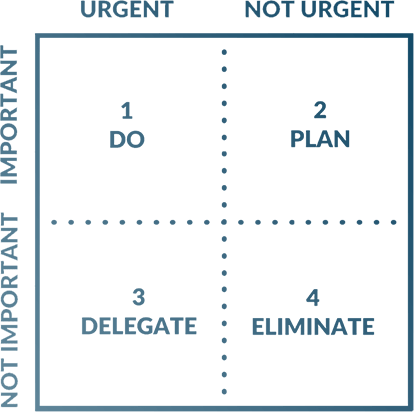
Have your client fill out all 4 quadrants:
Quadrant 1: Urgent and Important
This includes activities like getting the taxes done and hitting a major project deadline at work.
Quadrant 2: Not Urgent but Important
This includes activities like working out and creating a savings plan.
Quadrant 3: Urgent and Not Important
This includes activities like attending weekly work meetings
Quadrant 4: Not Urgent and Not Important
This includes activities like scrolling through Facebook or Instagram, and binge-watching a Netflix series. Everything we want to do and probably should every now and then for our own sanity, but they're definitely time-consumers and at the bottom of the priority list.
Quadrant 1 activities need to be done now, Quadrant 2 can be planned for later.
Activities in Quadrant 3 can often be delegated, and you can usually delete or eliminate what's in Quadrant 4.
The Eisenhower Matrix is one the most effective coaching techniques you can use to help clients boost productivity and take charge of their time and their life.
It's a powerful, simple and elegant tool that will help your clients identify time-wasting tasks, and give them the clarity and focus they need to prioritize their time and quickly achieve their goals.
The Art of Powerful Coaching Questions
Discover the 21 most powerful
coaching questions
To elevate your coaching skills, and trigger powerful aha moments during any coaching session, what any client.
